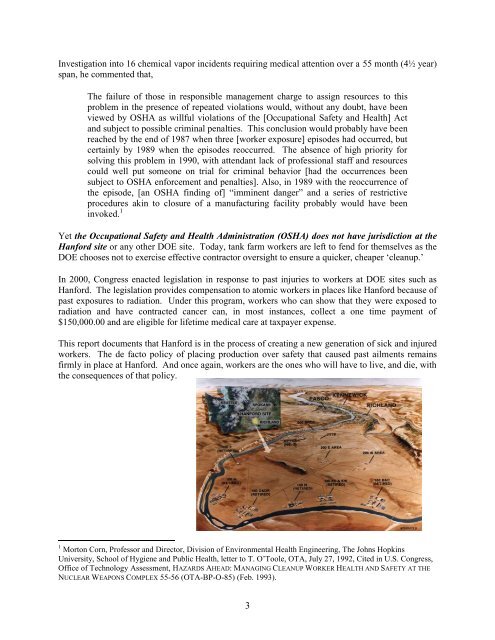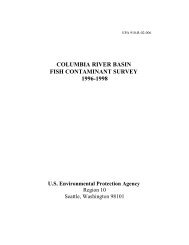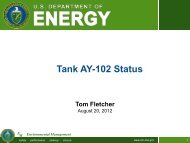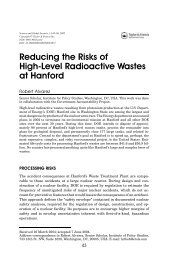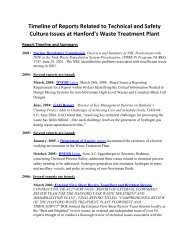Knowing Endangerment - Hanford Challenge
Knowing Endangerment - Hanford Challenge
Knowing Endangerment - Hanford Challenge
You also want an ePaper? Increase the reach of your titles
YUMPU automatically turns print PDFs into web optimized ePapers that Google loves.
Investigation into 16 chemical vapor incidents requiring medical attention over a 55 month (4½ year)<br />
span, he commented that,<br />
The failure of those in responsible management charge to assign resources to this<br />
problem in the presence of repeated violations would, without any doubt, have been<br />
viewed by OSHA as willful violations of the [Occupational Safety and Health] Act<br />
and subject to possible criminal penalties. This conclusion would probably have been<br />
reached by the end of 1987 when three [worker exposure] episodes had occurred, but<br />
certainly by 1989 when the episodes reoccurred. The absence of high priority for<br />
solving this problem in 1990, with attendant lack of professional staff and resources<br />
could well put someone on trial for criminal behavior [had the occurrences been<br />
subject to OSHA enforcement and penalties]. Also, in 1989 with the reoccurrence of<br />
the episode, [an OSHA finding of] “imminent danger” and a series of restrictive<br />
procedures akin to closure of a manufacturing facility probably would have been<br />
invoked. 1<br />
Yet the Occupational Safety and Health Administration (OSHA) does not have jurisdiction at the<br />
<strong>Hanford</strong> site or any other DOE site. Today, tank farm workers are left to fend for themselves as the<br />
DOE chooses not to exercise effective contractor oversight to ensure a quicker, cheaper „cleanup.‟<br />
In 2000, Congress enacted legislation in response to past injuries to workers at DOE sites such as<br />
<strong>Hanford</strong>. The legislation provides compensation to atomic workers in places like <strong>Hanford</strong> because of<br />
past exposures to radiation. Under this program, workers who can show that they were exposed to<br />
radiation and have contracted cancer can, in most instances, collect a one time payment of<br />
$150,000.00 and are eligible for lifetime medical care at taxpayer expense.<br />
This report documents that <strong>Hanford</strong> is in the process of creating a new generation of sick and injured<br />
workers. The de facto policy of placing production over safety that caused past ailments remains<br />
firmly in place at <strong>Hanford</strong>. And once again, workers are the ones who will have to live, and die, with<br />
the consequences of that policy.<br />
1 Morton Corn, Professor and Director, Division of Environmental Health Engineering, The Johns Hopkins<br />
University, School of Hygiene and Public Health, letter to T. O‟Toole, OTA, July 27, 1992, Cited in U.S. Congress,<br />
Office of Technology Assessment, HAZARDS AHEAD: MANAGING CLEANUP WORKER HEALTH AND SAFETY AT THE<br />
NUCLEAR WEAPONS COMPLEX 55-56 (OTA-BP-O-85) (Feb. 1993).<br />
3


